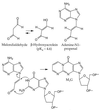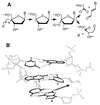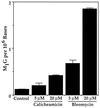Indirect mutagenesis by oxidative DNA damage: formation of the pyrimidopurinone adduct of deoxyguanosine by base propenal
- PMID: 9736698
- PMCID: PMC21604
- DOI: 10.1073/pnas.95.19.11113
Indirect mutagenesis by oxidative DNA damage: formation of the pyrimidopurinone adduct of deoxyguanosine by base propenal
Abstract
Oxidation of endogenous macromolecules can generate electrophiles capable of forming mutagenic adducts in DNA. The lipid peroxidation product malondialdehyde, for example, reacts with DNA to form M1G, the mutagenic pyrimidopurinone adduct of deoxyguanosine. In addition to free radical attack of lipids, DNA is also continuously subjected to oxidative damage. Among the products of oxidative DNA damage are base propenals. We hypothesized that these structural analogs of malondialdehyde would react with DNA to form M1G. Consistent with this hypothesis, we detected a dose-dependent increase in M1G in DNA treated with calicheamicin and bleomycin, oxidizing agents known to produce base propenal. The hypothesis was proven when we determined that 9-(3-oxoprop-1-enyl)adenine gives rise to the M1G adduct with greater efficiency than malondialdehyde itself. The reactivity of base propenals to form M1G and their presence in the target DNA suggest that base propenals derived from oxidative DNA damage may contribute to the mutagenic burden of a cell.
Figures




Similar articles
-
The exocyclic 1,N2-deoxyguanosine pyrimidopurinone M1G is a chemically stable DNA adduct when placed opposite a two-base deletion in the (CpG)3 frameshift hotspot of the Salmonella typhimurium hisD3052 gene.Biochemistry. 2001 Dec 25;40(51):15638-49. doi: 10.1021/bi011242u. Biochemistry. 2001. PMID: 11747439
-
Comparison of DNA adduct levels associated with oxidative stress in human pancreas.Mutat Res. 1998 Sep 20;405(2):125-33. doi: 10.1016/s0027-5107(98)00129-8. Mutat Res. 1998. PMID: 9748537
-
Structure of the malondialdehyde deoxyguanosine adduct M1G when placed opposite a two-base deletion in the (CpG)3 frameshift hotspot of the Salmonella typhimurium hisD3052 gene.Adv Exp Med Biol. 2001;500:513-6. doi: 10.1007/978-1-4615-0667-6_77. Adv Exp Med Biol. 2001. PMID: 11764989
-
Chemistry and biology of DNA damage by malondialdehyde.IARC Sci Publ. 1999;(150):17-27. IARC Sci Publ. 1999. PMID: 10626205 Review.
-
Lipid peroxidation-DNA damage by malondialdehyde.Mutat Res. 1999 Mar 8;424(1-2):83-95. doi: 10.1016/s0027-5107(99)00010-x. Mutat Res. 1999. PMID: 10064852 Review.
Cited by
-
Oxidative stress increases M1dG, a major peroxidation-derived DNA adduct, in mitochondrial DNA.Nucleic Acids Res. 2018 Apr 20;46(7):3458-3467. doi: 10.1093/nar/gky089. Nucleic Acids Res. 2018. PMID: 29438559 Free PMC article.
-
Structural and functional analysis of Sulfolobus solfataricus Y-family DNA polymerase Dpo4-catalyzed bypass of the malondialdehyde-deoxyguanosine adduct.Biochemistry. 2009 Aug 4;48(30):7079-88. doi: 10.1021/bi9003588. Biochemistry. 2009. PMID: 19492857 Free PMC article.
-
An endogenous DNA adduct as a prognostic biomarker for hepatocarcinogenesis and its prevention by Theaphenon E in mice.Hepatology. 2018 Jan;67(1):159-170. doi: 10.1002/hep.29380. Epub 2017 Nov 13. Hepatology. 2018. PMID: 28718980 Free PMC article.
-
Malondialdehyde-deoxyguanosine adduct formation in workers of pathology wards: the role of air formaldehyde exposure.Chem Res Toxicol. 2010 Aug 16;23(8):1342-8. doi: 10.1021/tx100083x. Chem Res Toxicol. 2010. PMID: 20707408 Free PMC article.
-
Pyrimido[1,2-a]-purin-10(3H)-one, M1G, is less prone to artifact than base oxidation.Nucleic Acids Res. 2005 Nov 10;33(19):6426-34. doi: 10.1093/nar/gki944. Print 2005. Nucleic Acids Res. 2005. PMID: 16282591 Free PMC article.
References
Publication types
MeSH terms
Substances
Grants and funding
LinkOut - more resources
Full Text Sources

